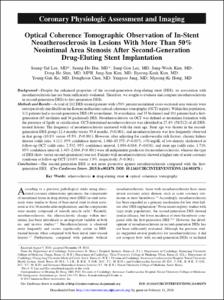KUMEL Repository
1. Journal Papers (연구논문)
1. School of Medicine (의과대학)
Dept. of Internal Medicine (내과학)
Optical Coherence Tomographic Observation of In-Stent Neoatherosclerosis in Lesions With More Than 50% Neointimal Area Stenosis After Second-Generation Drug-Eluting Stent Implantation
- Keimyung Author(s)
- Hur, Seung Ho
- Department
- Dept. of Internal Medicine (내과학)
- Journal Title
- Circulation: Cardiovascular Interventions
- Issued Date
- 2015
- Volume
- 8
- Issue
- 2
- Abstract
- Background—Despite the enhanced properties of the second-generation drug-eluting stent (DES), its association with neoatherosclerosis has not been sufficiently evaluated. Therefore, we sought to evaluate and compare neoatherosclerosis in second-generation DESs to first-generation DESs.
Methods and Results—A total of 212 DES-treated patients with >50% percent neointimal cross-sectional area stenosis were retrospectively enrolled from the Korean multicenter optical coherence tomography (OCT) registry. Within this population, 111 patients had a second-generation DES (40 zotarolimus, 36 everolimus, and 35 biolimus) and 101 patients had a first-generation (65 sirolimus and 36 paclitaxel) DES. Neoatherosclerosis on OCT was defined as neointima formation with the presence of lipids or calcification. OCT-determined neoatherosclerosis was identified in 27.4% (58/212) of all DES-treated lesions. The frequency of neoatherosclerosis increased with the stent age. Stent age was shorter in the second-generation DES group (12.4 months versus 55.4 months, P<0.001), and neoatherosclerosis was less frequently observed in that group (10.8% versus 45.5%, P<0.001). However, after adjusting for cardiovascular risk factors, chronic kidney disease (odds ratio, 4.113; 95% confidence interval, 1.086–15.575; P=0.037), >70 mg/dL of low-density cholesterol at follow-up OCT (odds ratio, 2.532; 95% confidence interval, 1.054–6.084; P=0.038), and stent age (odds ratio, 1.710; 95% confidence interval, 1.403–2.084; P<0.001) were all independent predictors for neoatherosclerosis, whereas the type of DES (first- versus second-generation) was not. Patients with neoatherosclerosis showed a higher rate of acute coronary syndrome at follow-up OCT (19.0% versus 3.9%, respectively, P=0.001).
Conclusions—The second-generation DES is not more protective against neoatherosclerosis compared with the first-generation DES.
Key Words: atherosclerosis
drug-eluting stent
optical coherence tomography
- Keimyung Author(s)(Kor)
- 허승호
- Publisher
- School of Medicine
- Citation
- Seung-Yul Lee et al. (2015). Optical Coherence Tomographic Observation of In-Stent Neoatherosclerosis in Lesions With More Than 50% Neointimal Area Stenosis After Second-Generation Drug-Eluting Stent Implantation. Circulation: Cardiovascular Interventions, 8(2), e001878–e001878. doi: 10.1161/CIRCINTERVENTIONS.114.001878
- Type
- Article
- ISSN
- 1941-7640
- Appears in Collections:
- 1. School of Medicine (의과대학) > Dept. of Internal Medicine (내과학)
- 파일 목록
-
-
Download
 oak-aaa-00947.pdf
기타 데이터 / 646.79 kB / Adobe PDF
oak-aaa-00947.pdf
기타 데이터 / 646.79 kB / Adobe PDF
-
Items in Repository are protected by copyright, with all rights reserved, unless otherwise indicated.